Abstract
Of 59 women referred with vulval warts whose cervices were assessed colposcopically for the presence of cervical intraepithelial neoplasia (CIN) before local treatment of the wart lesions, 17 had histologically proved CIN, 12 had histologically proved cervical wart virus infection, and 30 had abnormality on colposcopy or cytology. Seven of the 17 with CIN had no abnormality on cervical cytology. No differences in sexual behaviour, smoking habit, or oral contraceptive use were seen between women with CIN and those with no cervical abnormality. Viral DNA typing of the vulval lesions was carried out, but there were no differences in the distribution of viral types between the three different histological groups. Of the 30 women with no abnormality at the initial visit, 23 were followed up colposcopically and cytologically for one to two years. Three of them developed CIN after adequate treatment of the vulval lesions despite the absence of cervical abnormalities on colposcopy at the time of treatment. Studying the known factors linked with CIN failed to show why some women with vulval warts develop CIN, even after treatment of the warts, and others do not. The large number of false negative results on cervical cytology in our patients suggests that women presenting with vulval warts should be screened colposcopically in the first instance. Close follow up of women whose warts are treated and who are thought to have no cervical abnormality at that assessment is essential.
Full text
PDF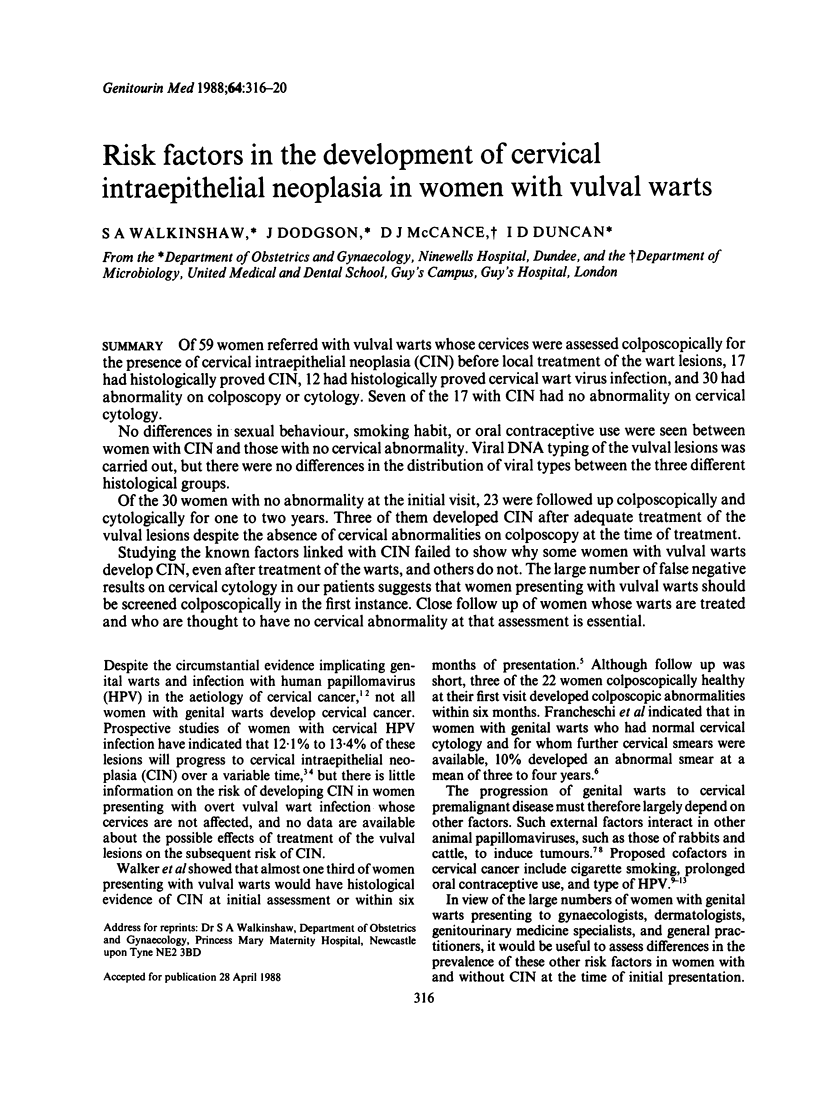
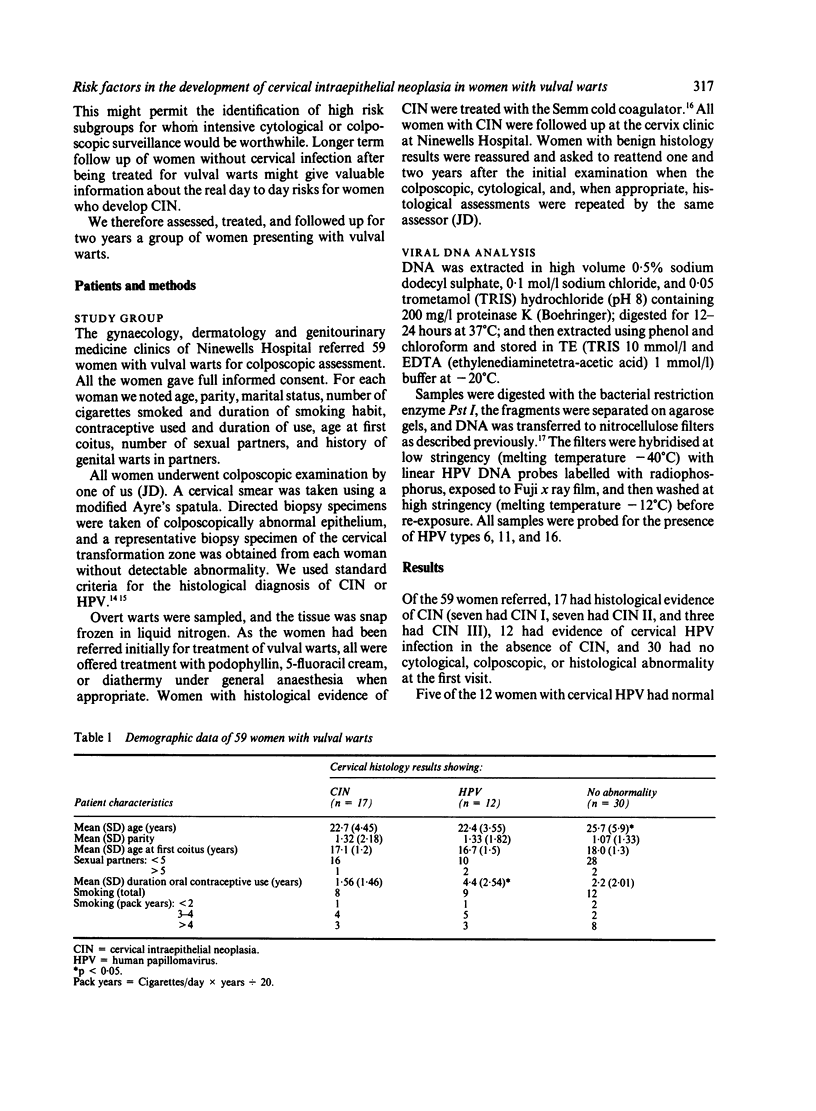
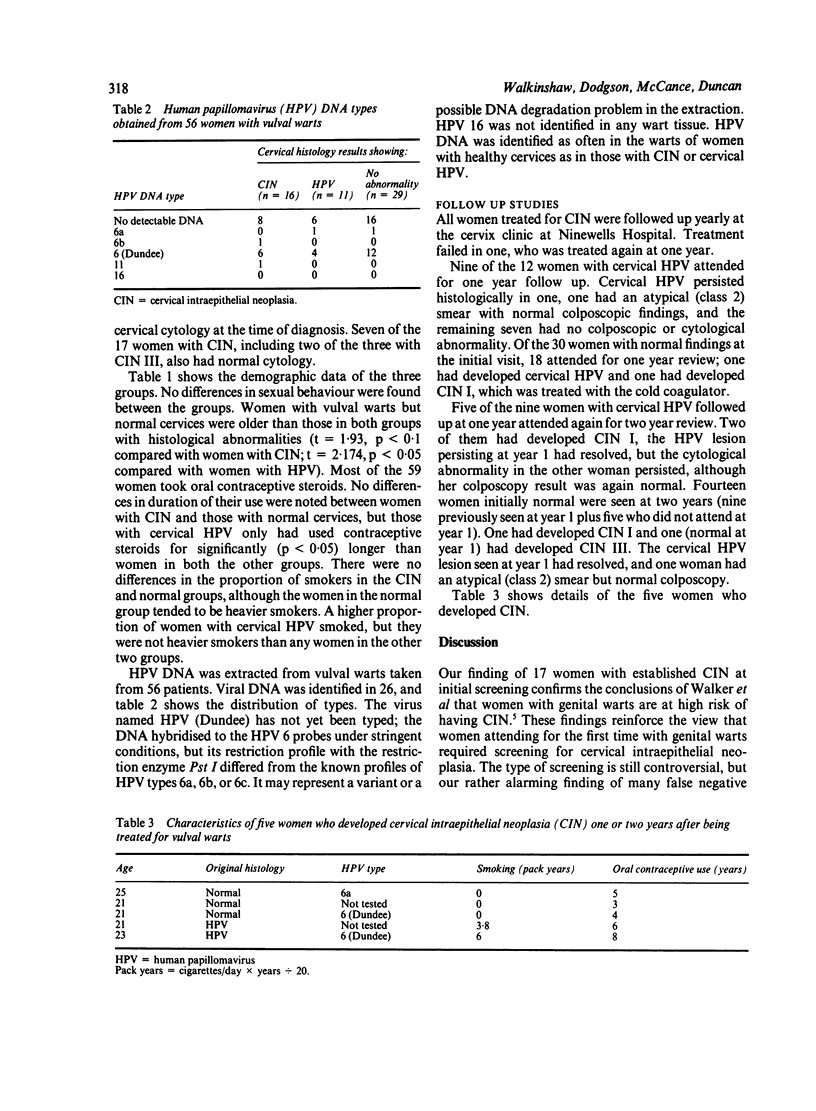
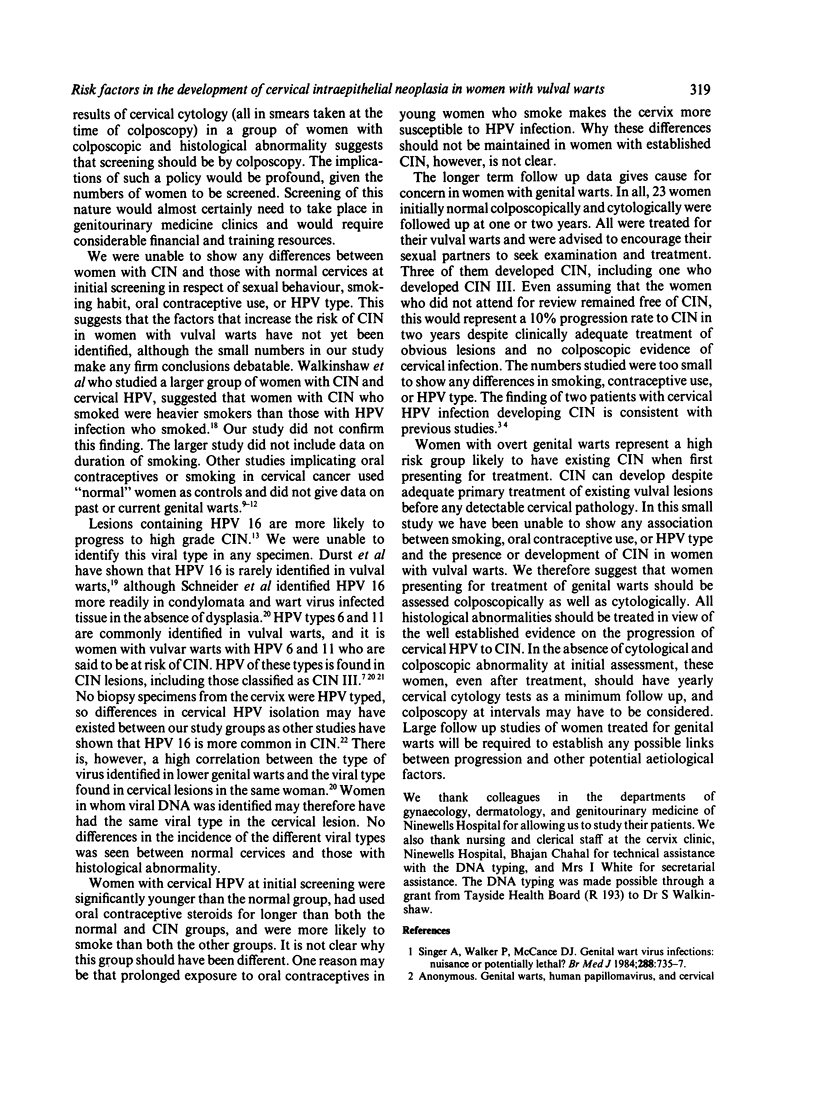
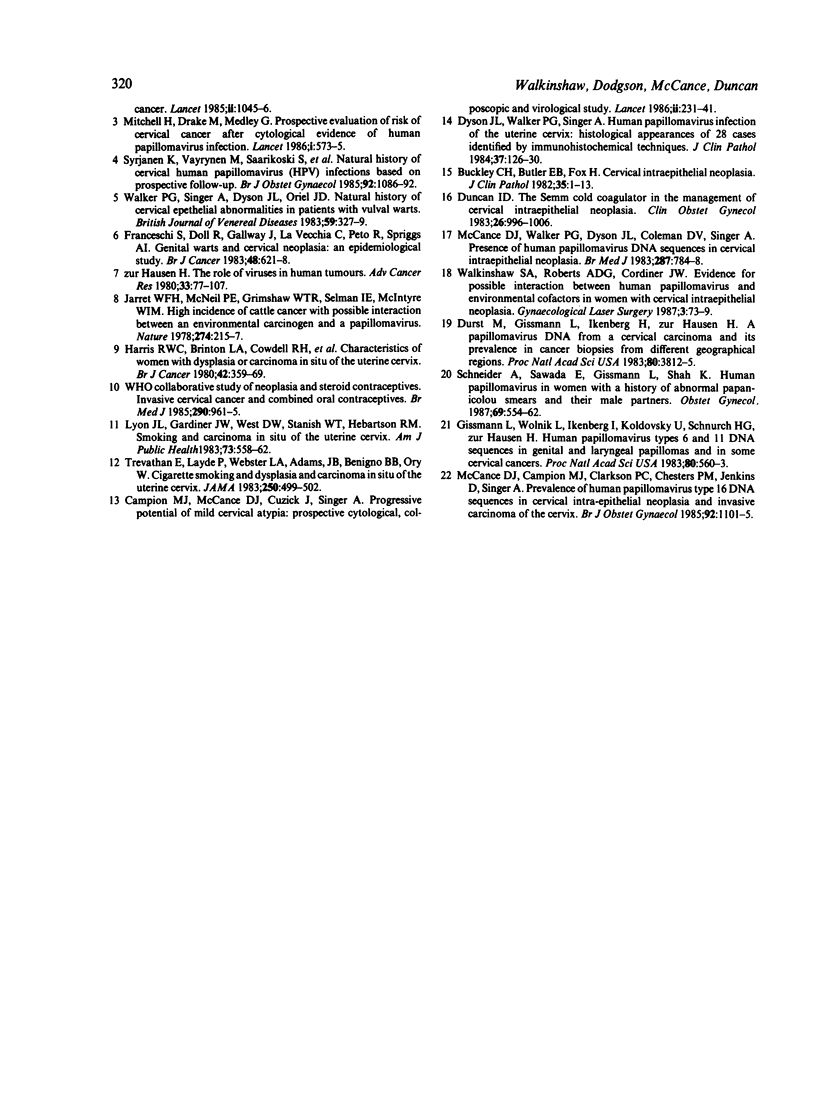
Selected References
These references are in PubMed. This may not be the complete list of references from this article.
- Buckley C. H., Butler E. B., Fox H. Cervical intraepithelial neoplasia. J Clin Pathol. 1982 Jan;35(1):1–13. doi: 10.1136/jcp.35.1.1. [DOI] [PMC free article] [PubMed] [Google Scholar]
- Duncan I. D. The Semm cold coagulator in the management of cervical intraepithelial neoplasia. Clin Obstet Gynecol. 1983 Dec;26(4):996–1006. doi: 10.1097/00003081-198312000-00022. [DOI] [PubMed] [Google Scholar]
- Dyson J. L., Walker P. G., Singer A. Human papillomavirus infection of the uterine cervix: histological appearances in 28 cases identified by immunohistochemical techniques. J Clin Pathol. 1984 Feb;37(2):126–130. doi: 10.1136/jcp.37.2.126. [DOI] [PMC free article] [PubMed] [Google Scholar]
- Dürst M., Gissmann L., Ikenberg H., zur Hausen H. A papillomavirus DNA from a cervical carcinoma and its prevalence in cancer biopsy samples from different geographic regions. Proc Natl Acad Sci U S A. 1983 Jun;80(12):3812–3815. doi: 10.1073/pnas.80.12.3812. [DOI] [PMC free article] [PubMed] [Google Scholar]
- Franceschi S., Doll R., Gallwey J., La Vecchia C., Peto R., Spriggs A. I. Genital warts and cervical neoplasia: an epidemiological study. Br J Cancer. 1983 Nov;48(5):621–628. doi: 10.1038/bjc.1983.243. [DOI] [PMC free article] [PubMed] [Google Scholar]
- Gissmann L., Wolnik L., Ikenberg H., Koldovsky U., Schnürch H. G., zur Hausen H. Human papillomavirus types 6 and 11 DNA sequences in genital and laryngeal papillomas and in some cervical cancers. Proc Natl Acad Sci U S A. 1983 Jan;80(2):560–563. doi: 10.1073/pnas.80.2.560. [DOI] [PMC free article] [PubMed] [Google Scholar]
- Harris R. W., Brinton L. A., Cowdell R. H., Skegg D. C., Smith P. G., Vessey M. P., Doll R. Characteristics of women with dysplasia or carcinoma in situ of the cervix uteri. Br J Cancer. 1980 Sep;42(3):359–369. doi: 10.1038/bjc.1980.246. [DOI] [PMC free article] [PubMed] [Google Scholar]
- Jarrett W. F., McNeil P. E., Grimshaw W. T., Selman I. E., McIntyre W. I. High incidence area of cattle cancer with a possible interaction between an environmental carcinogen and a papilloma virus. Nature. 1978 Jul 20;274(5668):215–217. doi: 10.1038/274215a0. [DOI] [PubMed] [Google Scholar]
- McCance D. J., Walker P. G., Dyson J. L., Coleman D. V., Singer A. Presence of human papillomavirus DNA sequences in cervical intraepithelial neoplasia. Br Med J (Clin Res Ed) 1983 Sep 17;287(6395):784–788. doi: 10.1136/bmj.287.6395.784. [DOI] [PMC free article] [PubMed] [Google Scholar]
- Mitchell H., Drake M., Medley G. Prospective evaluation of risk of cervical cancer after cytological evidence of human papilloma virus infection. Lancet. 1986 Mar 15;1(8481):573–575. doi: 10.1016/s0140-6736(86)92807-2. [DOI] [PubMed] [Google Scholar]
- Singer A., Walker P. G., McCance D. J. Genital wart virus infections: nuisance or potentially lethal? Br Med J (Clin Res Ed) 1984 Mar 10;288(6419):735–737. doi: 10.1136/bmj.288.6419.735. [DOI] [PMC free article] [PubMed] [Google Scholar]
- Syrjänen K., Väyrynen M., Saarikoski S., Mäntyjärvi R., Parkkinen S., Hippeläinen M., Castren O. Natural history of cervical human papillomavirus (HPV) infections based on prospective follow-up. Br J Obstet Gynaecol. 1985 Nov;92(11):1086–1092. [PubMed] [Google Scholar]
- Trevathan E., Layde P., Webster L. A., Adams J. B., Benigno B. B., Ory H. Cigarette smoking and dysplasia and carcinoma in situ of the uterine cervix. JAMA. 1983 Jul 22;250(4):499–502. [PubMed] [Google Scholar]
- Walker P. G., Singer A., Dyson J. L., Oriel J. D. Natural history of cervical epithelial abnormalities in patients with vulval warts. A colposcopic study. Br J Vener Dis. 1983 Oct;59(5):327–329. doi: 10.1136/sti.59.5.327. [DOI] [PMC free article] [PubMed] [Google Scholar]
- zur Hausen H. The role of viruses in human tumors. Adv Cancer Res. 1980;33:77–107. doi: 10.1016/s0065-230x(08)60669-7. [DOI] [PubMed] [Google Scholar]


